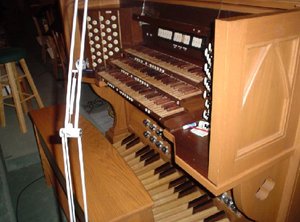Organ stop
|
|
An organ stop can mean either:
- The control on an organ console that selects a particular sound.
- The mechanism, and in particular the organ pipes, used to produce a particular sound.
- The sound itself.
Stops have particular names according to the kind of pipes used to create the sound and the style of organ.
Single-rank stops, the majority, are usually marked with an arabic numeral indicating the pitch; it originated as the length, in feet, of the rank's longest pipe. Registration usually begins with an 8' on the manual and a 16' on the pedal; the pedal thus normally sounds an octave lower than played, providing the "full-bodied" sound typical of the organ. Halving the number raises the pitch by an octave; in growing a registration it is usual to draw next the 4', 2', etc. on the manual and the 8', 4', etc. on the pedal. Numbers other than powers of 2 appear; these are called mutations. The 5 1/3', 2 2/3', 1 1/3' series sounds a G for a C; the rarer 3 1/5', 1 3/5', 4/5' sounds an E for a C.
The most common multi-rank stops are mixtures, and are usually marked with a roman numeral indicating the number of ranks. Though it seems somehow wasteful to not provide the ranks separately, a mixture rank may break - drop an octave - as one goes up the scale to avoid shrillness, making it inappropriate for use apart. The name applied to the mixture usually codes for the particular chord provided, but octaves and fifths are most common; e.g. a Quint III might provide the 5th, 8ve, and 12th; an Acuta IV might have the 15th, 17th, 19th, and 23rd. Mixtures are usually used to boost harmonics, but some are appropriate as solo stops.
The next most common multi-rank stops are celestes, two identical ranks except one is slightly out of tune. But celestes are often presented as pairs of stops, since they don't break like mixtures.
Sometimes a single rank has multiple stops. In one form, a divided or half stop, only the higher or lower pipes are drawn on. In another form, borrowing or unification, each stop may draw the rank to a different keyboard or to one keyboard at different pitches.
Flue stops, such as principals, flutes, and strings, are essentially end-blown whistles. Reed stops, such as trumpets or vox humanas consist of a metal reed vibrating in a full- or partial-length resonator. Short-length reed resonators of unusual shape are often called "vowel chambers."
Names of stops are somewhat organ builder specific - a stop with a same name can have slightly different timbres on different organs.
| Contents |
Mechanics of the Organ Stops
In pipe organs, each key on a keyboard is connected to each pipe in the ranks or rows of pipes connected to that particular keyboard. When the key is pressed, air is allowed to flow up from the blower.

In order to control what pipes will sound, stops were developed for organs. A stop is made up of material that fits underneath the pipes for each row, or rows in mixture stop. When the stop is closed, the air is kept from flowing up into the pipes in that rank. When the stop knob is pulled out, the material slides out from under the pipe. When a key for the rank's division is pushed, the air from the windchest is allowed to flow up, and into the pipe to create the noise. If more than one rank is open, the air will flow into the pipes in each open rank. This gives the organist a great deal of flexibility in what sound the organ will produce.
Organ consoles are connected to the stops by varying means. Those organs that have a console where the stop knobs are directly connected to the stops are referred to as having mechanical action. Those that are not directly connected often rely on electronics to control the opening and closing of a stop.
In electronic organs that do not have pipes, opening a stop merely adds the "rank" in question through various means. The means used have changed over the years since the introduction of the electric organ in the first part of the 20th century.
Common Stop Names
- principal - usually available in several sizes
- mixture - the most generic sort of compound stop
- gamba - a rank of narrow-scaled pipes, giving a string-like sound
- bourdon - usually a stopped flute of a low pitch
- diapason - generally synonymous with principal
- voix cÚleste - a stop that is intentionally tuned slightly off-pitch
- vox humana - a type of reed stop
- trumpet - a loud reed stop, usually with full-length resonators flared to form a bell
- trombone
- flute - a rank of broad-scaled pipes, open, covered, chimneyed, or conical, giving a sound similar to a flute or a recorder
- flautino
- oboe - a reed stop that produces a sound similar to the orchestral instrument
- cello - similar to gamba
- bombarde - an exceptionally loud reed stop, or a division containing several exceptionally loud reed stops
See also list of pipe organ stops.
Further reading
- Stevens Irwin Dictionary of Pipe Organ Stops
- George Ashdown Audsley Organ Stops and Their Artistic Registration
External links
- Encyclopedia of Organ Stops (http://www.organstops.org)de:Orgelregister
